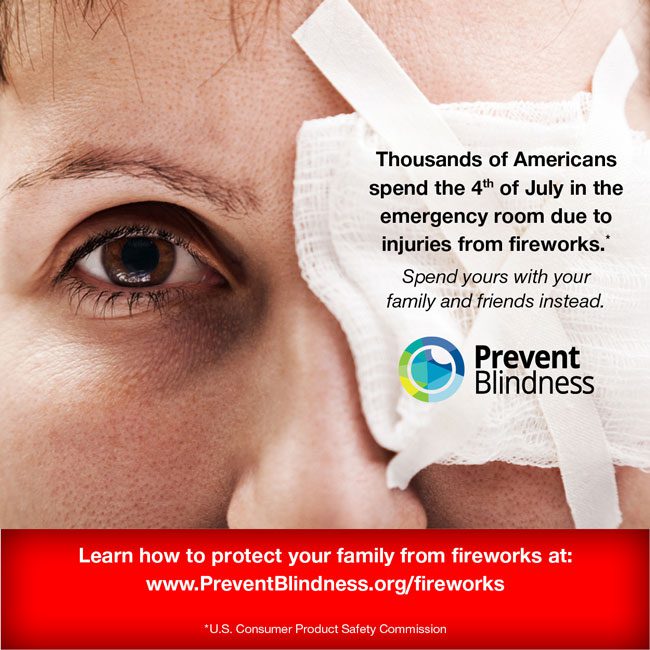Prevent Blindness Declares June 28-July 4, 2021 as “Fireworks Safety Awareness Week” to Educate Public on Dangers of Using Fireworks
Prevent Blindness has declared June 28-July 4, 2021 as Fireworks Safety Awareness Week, to help educate the public on the dangers of fireworks. Whether at home or by attending professional displays, fireworks seriously injure thousands of people every year, with some injuries even resulting in death.
Burns were reported to be the most common injury to hands, fingers, arms, and legs. However, contusions and lacerations were the most frequent injuries to eyes, which included foreign bodies in the eye.
During Fireworks Safety Awareness Week, Prevent Blindness will post messages on its various social media channels, as well as offer free shareable materials including fact sheets and social media graphics. Prevent Blindness has also issued its own Fireworks Position Statement.
Recently, the United States Consumer Product Safety Commission (CPSC) issued a report comparing product injury estimate data from March 2020 through September 2020, to the estimate data from March 2019 through September 2019. The report showed that emergency department visits for injuries involving fireworks increased significantly — by 56 percent, the highest percentage injury increase across all age groups of any product tracked during this time period. In addition, more than 79 percent of fireworks-related injuries occurred at home in the 2020 period whereas an estimated 68 percent of fireworks-related injuries occurred at home in 2019.
Additionally, a recent online survey of U.S. adults from the American Academy of Ophthalmology (AAO) found that 39 percent of parents said that children age 5 to 7 should be allowed to handle sparklers. Yet sparklers can burn up to 1,800 degrees. And, 27 percent of parents responded that children age 11 to 15 should be allowed to handle fireworks, even though data shows that children younger than 15 years of age account for 36 percent of estimated fireworks-related injuries.
The AAO survey also found that:
- 33 percent overall know someone injured by fireworks or have been injured by fireworks.
- 8 percent report being injured by fireworks.
- 27 percent knew someone else injured by fireworks.
The American Pyrotechnics Association lists Massachusetts as the only state with a ban on all consumer fireworks. Illinois, Ohio and Vermont allow only wire or wood stick sparklers and other novelty items. However, Senate Bill 113 in the state of Ohio is currently being pushed through, despite strong objections from a range of public health and safety groups including Prevent Blindness, Ohio Affiliate, to allow consumer discharge of fireworks after a decades-long ban. Additionally, a recent poll conducted by Prevent Blindness showed that 88 percent of Ohio respondents were also against backyard fireworks.
“This Fourth of July holiday has special significance for many of us as the nation slowly emerges from the many effects of the COVID-19 pandemic,” said Jeff Todd, president and CEO of Prevent Blindness. “We strongly encourage everyone to celebrate with their family, friends and neighbors safely and avoid using fireworks.”
For more information on the dangers of fireworks, please call Prevent Blindness at (800) 331-2020, or visit https://www.preventblindness.org/fireworks.
Download the 2021 Prevent Blindness fireworks safety press release.

